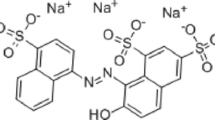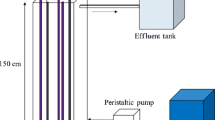Abstract
The efficiency, transformation products, and mechanism of phycocyanin removal from water by simulated sunlight/Cu-decorated TiO2 photocatalyst treatment were studied. After 360 min of photocatalytic degradation, the removal rate of PC was higher than 96%, about 47% of DON was oxidized into NH4+-N, NO3− and NO2−. ·OH was the main active species in the photocatalytic system, which contributes about 55.7% to PC degradation efficiency, H+ and ·O2− also contributed to the photocatalytic activity. The degradation process of phycocyanin is firstly caused by the attack of free radicals, which leads to the disintegration of the chromophore group PCB and the apoprotein, and then apoprotein peptide chain was broken to generate small molecule dipeptides, amino acids, and their derivatives. Amino acid residues sensitive to free radical action in phycocyanin peptide chain include most hydrophobic amino acids such as leucine, isoleucine, proline, valine, phenylalanine, and some hydrophilic amino acids which are easily oxidized such as lysine and arginine. Small molecular peptides (dipeptides), amino acids, and their derivatives are broken off and released into water bodies for further reaction and degradation into smaller molecular weight substances. During this process, part of organic nitrogen was transferred to inorganic nitrogen. When photocatalytic oxidation lasts for 300 min, NH4+ increases from 0.41 mg/L to 2.21 mg/L, and DON removal rate reaches 47%. The Cu-TiO2 photocatalyst was found to decrease the CHCl3 formation potential; however, it exacerbated the production of dichloroacetamide (DCAcAm) and dichloroacetonitrile (DCAN) beyond their initial levels. The divergent trends of these disinfection by-products are due to the fundamental differences in the precursor material.








Similar content being viewed by others
Data availability
Not applicable.
References
Abidi M, Assadi AA, Bouzaza A, Hajjaji A, Bessais B, Rtimi S (2019) Photocatalytic indoor/outdoor air treatment and bacterial inactivation on CuxO/TiO2 prepared by HiPIMS on polyester cloth under low intensity visible light. Appl Catal B: Environ 259:118074. https://doi.org/10.1016/j.apcatb.2019.118074
Aijo John K, Naduvath J, Remillard SK, Shaji S, DeYoung PA, Kellner ZT, Mallick S, Thankamoniamma M, Okram GS, Philip RR (2019) A simple method to fabricate metal doped TiO2 nanotubes. Chem Phys 523:198–204. https://doi.org/10.1016/j.chemphys.2019.04.028
Cao Z, Liu C, Chen D, Liu J (2019) Preparation of an Au-TiO2 photocatalyst and its performance in removing phycocyanin. Sci Total Environ 692:572–581. https://doi.org/10.1016/j.scitotenv.2019.07.117
Chang H, Chen C, Wang G (2013) Characteristics of C-, N-DBPs formation from nitrogen-enriched dissolved organic matter in raw water and treated wastewater effluent. Water Res 47(8):2729–2741. https://doi.org/10.1016/j.watres.2013.02.033
Chu W, Gao N, Deng Y (2010) Formation of haloacetamides during chlorination of dissolved organic nitrogen aspartic acid. J Hazard Mater 173(1–3):82–86. https://doi.org/10.1016/j.jhazmat.2009.08.051
Daghrir R, Drogui P, Robert D (2013) Modified TiO2 for environmental photocatalytic applications: a review. Ind Eng Chem Res 52(10):3581–3599. https://doi.org/10.1021/ie303468t
Duan H, Tao M, Loiselle SA, Zhao W, Cao Z, Ma R, Tang X (2017) MODIS observations of cyanobacterial risks in a eutrophic lake: implications for long-term safety evaluation in drinking-water source. Water Res 122:455–470. https://doi.org/10.1016/j.watres.2017.06.022
Gerrity D, Mayer B, Ryu H, Crittenden J, Abbaszadegan M (2009) A comparison of pilot-scale photocatalysis and enhanced coagulation for disinfection byproduct mitigation. Water Res 43(6):1597–1610. https://doi.org/10.1016/j.watres.2009.01.010
Hoffmann MR, Martin ST, Choi W, Bahnemann DW (1995) Environmental applications of semiconductor photocatalysis. Chem Rev 95(1):69–96. https://doi.org/10.1021/cr00033a004
Hong HC, Mazumder A, Wong MH, Liang Y (2008) Yield of trihalomethanes and haloacetic acids upon chlorinating algal cells, and its prediction via algal cellular biochemical composition. Water Res 42(20):4941–4948. https://doi.org/10.1016/j.watres.2008.09.019
Hui-Li R, Hao H, Meng-Jun M, Jin-Sheng Z, Jia-Jie F (2017) Dye-sensitized solar cells based on double-layer composite film with enhanced photovoltaic performance. J Inorg Mater, 32(10), 1049–1054. https://doi.org/10.15541/jim20160703
Kumar A, Thakur PR, Sharma G, Vo D-VN, Naushad Mu, Tatarchuk T, García-Peñas A, Du B, Stadler FJ (2022) Accelerated charge transfer in well-designed S-scheme Fe@TiO2/boron carbon nitride heterostructures for high performance tetracycline removal and selective photo-reduction of CO2 greenhouse gas into CH4 fuel. Chemosphere 287:132301. https://doi.org/10.1016/j.chemosphere.2021.132301
Kumar VK, Rahman A, Adinath Sundaram S, Sinha RP (2016) Structural and functional dynamics of tyrosine amino acid in phycocyanin of hot-spring cyanobacteria: a possible pathway for internal energy transfer. Gene Reports, 5, 83–91https://doi.org/10.1016/j.genrep.2016.09.005
Kupka M, Scheer H (2008) Unfolding of C-phycocyanin followed by loss of non-covalent chromophore–protein interactions. Biochimica et Biophysica Acta (BBA) - Bioenergetics, 1777(1), 94–103. https://doi.org/10.1016/j.bbabio.2007.10.009
Lee W, Westerhoff P, Croue J-P (2007) Dissolved organic nitrogen as a precursor for chloroform, dichloroacetonitrile, N-nitrosodimethylamine, and trichloronitromethane. Environ Sci Technol 41(15):5485–5490. https://doi.org/10.1021/es070411g
Liu C, Cao Z, Wang J, Sun Z, He S, Chen W (2017) Performance and mechanism of phycocyanin removal from water by low-frequency ultrasound treatment. Ultrason Sonochem 34:214–221. https://doi.org/10.1016/j.ultsonch.2016.05.040
Liu C, Wang J, Chen W, Sun Z, Cao Z (2016) Performance and mechanism of UV/immobilized Cu-TiO2 system to degradation histidine. J Nanomater 2016:1–9. https://doi.org/10.1155/2016/8946019
Liu C, Zhao M, He S, Cao Z, Chen W (2018) Bicarbonate-enhanced removal of a typical amino acid using a cobalt(II)-catalyzed Fenton-like reaction in aqueous solution. Desalination and Water Treatment 108:216–222. https://doi.org/10.5004/dwt.2018.21956
Liu S, Lim M, Fabris R, Chow C, Drikas M, Amal R (2008) TiO(2) photocatalysis of natural organic matter in surface water: impact on trihalomethane and haloacetic acid formation potential. Environ Sci Technol 42(16):6218–6223. https://doi.org/10.1021/es800887s
Mayer BK, Daugherty E, Abbaszadegan M (2014) Disinfection byproduct formation resulting from settled, filtered, and finished water treated by titanium dioxide photocatalysis. Chemosphere 117:72–78. https://doi.org/10.1016/j.chemosphere.2014.05.073
Meng Y, Wang Y, Han Q, Xue N, Sun Y, Gao B, Li Q (2016) Trihalomethane (THM) formation from synergic disinfection of biologically treated municipal wastewater: effect of ultraviolet (UV) irradiation and titanium dioxide photocatalysis on dissolve organic matter fractions. Chem Eng J 303:252–260. https://doi.org/10.1016/j.cej.2016.05.141
Minero C, Mariella G, Maurino V, Pelizzetti E (2000) Photocatalytic transformation of organic compounds in the presence of inorganic anions. 1. Hydroxyl-mediated and direct electron-transfer reactions of phenol on a titanium dioxide−fluoride system. Langmuir, 16(6), 2632–2641. https://doi.org/10.1021/la9903301
Palominos R, Freer J, Mondaca MA, Mansilla HD (2008) Evidence for hole participation during the photocatalytic oxidation of the antibiotic flumequine. J Photochem Photobiol, A 193(2–3):139–145. https://doi.org/10.1016/j.jphotochem.2007.06.017
Pan C, Zhu Y (2010) New type of BiPO 4 oxy-acid salt photocatalyst with high photocatalytic activity on degradation of dye. Environ Sci Technol 44(14):5570–5574. https://doi.org/10.1021/es101223n
Pehlivanoglu-Mantas E, Sedlak DL (2008) Measurement of dissolved organic nitrogen forms in wastewater effluents: concentrations, size distribution and NDMA formation potential. Water Res 42(14):3890–3898. https://doi.org/10.1016/j.watres.2008.05.017
Pivokonsky M, Kloucek O, Pivokonska L (2006) Evaluation of the production, composition and aluminum and iron complexation of algogenic organic matter. Water Res 40(16):3045–3052. https://doi.org/10.1016/j.watres.2006.06.028
Plewa MJ, Wagner ED, Jazwierska P, Richardson SD, Chen PH, McKague AB (2004) Halonitromethane drinking water disinfection byproducts: chemical characterization and mammalian cell cytotoxicity and genotoxicity. Environ Sci Technol 38(1):62–68. https://doi.org/10.1021/es030477l
Plummer JD, Edzwald JK (2001) Effect of ozone on algae as precursors for trihalomethane and haloacetic acid production. Environ Sci Technol 35(18):3661–3668. https://doi.org/10.1021/es0106570
Prasse C, Stalter D, Schulte-Oehlmann U, Oehlmann J, Ternes TA (2015) Spoilt for choice: a critical review on the chemical and biological assessment of current wastewater treatment technologies. Water Res 87:237–270. https://doi.org/10.1016/j.watres.2015.09.023
Rtimi S, Kiwi J (2021) Update on interfacial charge transfer (IFTC) processes on films inactivating viruses/bacteria under visible light: mechanistic considerations and critical issues. Catalysts 11(2):201. https://doi.org/10.3390/catal11020201
Tatarchuk T, Peter A, Al-Najar B, Vijaya J, Bououdina M (2018) Photocatalysis: activity of nanomaterials. In Nanotechnology in Environmental Science (eds C.M. Hussain and A.K. Mishra). https://doi.org/10.1002/9783527808854.ch8
Tatarchuk T, Danyliuk N, Shyichuk A, Macyk W, Naushad Mu (2021) Photocatalytic degradation of dyes using rutile TiO2 synthesized by reverse micelle and low temperature methods: real-time monitoring of the degradation kinetics. J Mol Liq, 342, 117407. https://doi.org/10.1016/j.molliq.2021.117407
Tongchang P, Kumsuvan J, Phatthalung WN, Suksaroj C, Wongrueng A, Musikavong C (2018) Reduction by enhanced coagulation of dissolved organic nitrogen as a precursor of N-nitrosodimethylamine. J Environ Sci Health Part A-Toxic/hazardous Subs Environ Eng 53(6):583–593. https://doi.org/10.1080/10934529.2018.1428270
Verma P, Kumar M, Mishra G, Sahoo D (2017) Multivariate analysis of fatty acid and biochemical constitutes of seaweeds to characterize their potential as bioresource for biofuel and fine chemicals. Biores Technol 226:132–144. https://doi.org/10.1016/j.biortech.2016.11.044
Wang W-L, Wu Q-Y, Huang N, Xu Z-B, Lee M-Y, Hu H-Y (2018) Potential risks from UV/H2O2 oxidation and UV photocatalysis: a review of toxic, assimilable, and sensory-unpleasant transformation products. Water Res 141:109–125. https://doi.org/10.1016/j.watres.2018.05.005
Xu B, Ye T, Li D-P, Hu C-Y, Lin Y-L, Xia S-J, Tian F-X, Gao N-Y (2011) Measurement of dissolved organic nitrogen in a drinking water treatment plant: size fraction, fate, and relation to water quality parameters. Sci Total Environ 409(6):1116–1122. https://doi.org/10.1016/j.scitotenv.2010.12.016
Yoon Y, Lueptow RM (2005) Removal of organic contaminants by RO and NF membranes. J Membr Sci 261(1–2):76–86. https://doi.org/10.1016/j.memsci.2005.03.038
Yu J, Kiwi J, Wang T, Pulgarin C, Rtimi S (2019) Evidence for a dual mechanism in the TiO2/CuxO photocatalyst during the degradation of sulfamethazine under solar or visible light: critical issues. J Photochem Photobiol, A 375:270–279. https://doi.org/10.1016/j.jphotochem.2019.02.033
Funding
This work was supported by the National Natural Science Foundation of China (51378174), the Project Funded by the Priority Academic Program Development of Jiangsu Higher Education Institutions.
Author information
Authors and Affiliations
Contributions
Yuan-yuan Ren: writing—original draft, writing—review and editing, methodology, validation, formal analysis, and data curation. Cheng Liu: project administration, conceptualization, resources, and supervision. Zhen Cao: methodology. Cong-cong Li: writing—review and editing. Yu-lin Zheng: resources.
Corresponding author
Ethics declarations
Ethics approval and consent to participate
Not applicable.
Consent for publication
Not applicable.
Competing interests
The authors declare no competing interests.
Additional information
Responsible Editor: Sami Rtimi
Publisher's note
Springer Nature remains neutral with regard to jurisdictional claims in published maps and institutional affiliations.
Rights and permissions
Springer Nature or its licensor (e.g. a society or other partner) holds exclusive rights to this article under a publishing agreement with the author(s) or other rightsholder(s); author self-archiving of the accepted manuscript version of this article is solely governed by the terms of such publishing agreement and applicable law.
About this article
Cite this article
Ren, Yy., Liu, C., Cao, Z. et al. Performance and degradation mechanism of phycocyanin by Cu-TiO2 photocatalytic treatment. Environ Sci Pollut Res 30, 58304–58314 (2023). https://doi.org/10.1007/s11356-023-26080-8
Received:
Accepted:
Published:
Issue Date:
DOI: https://doi.org/10.1007/s11356-023-26080-8




